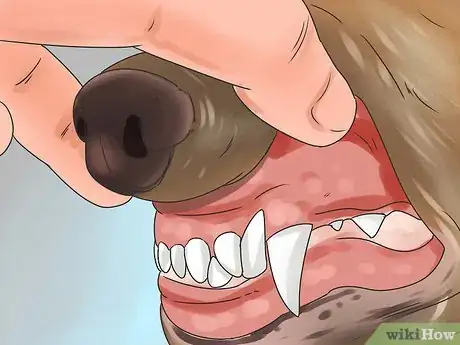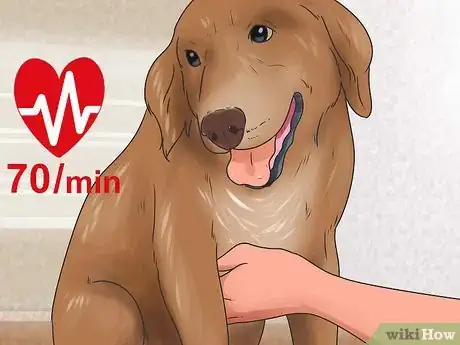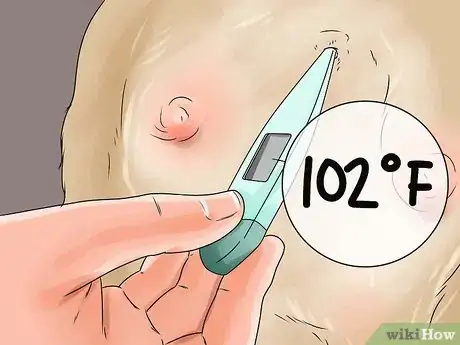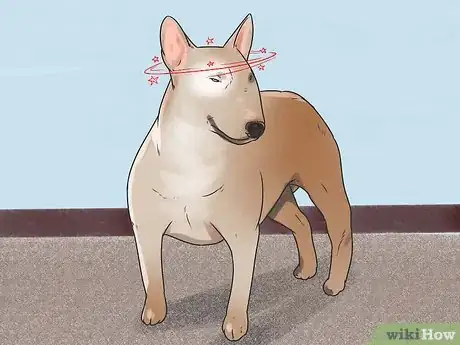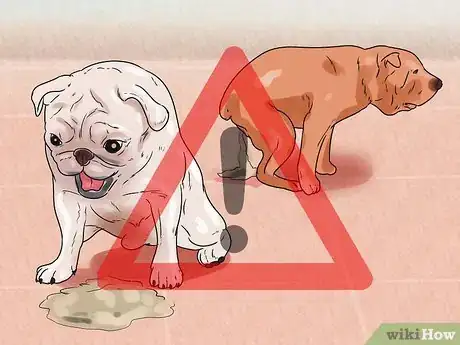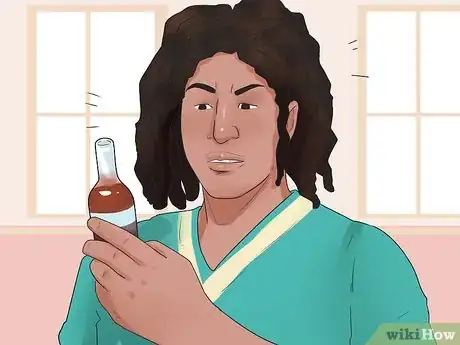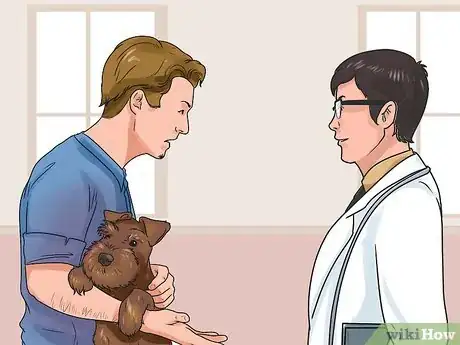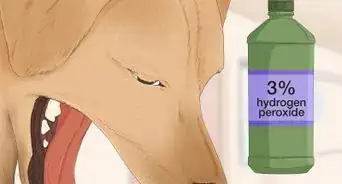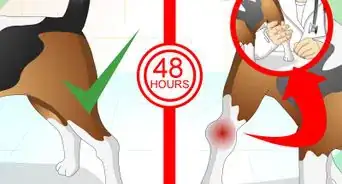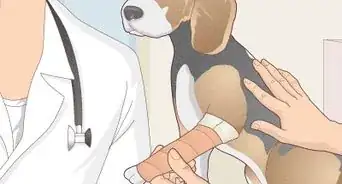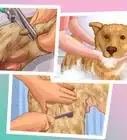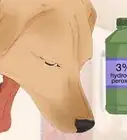This article was co-authored by Natalie Punt, DVM. Dr. Natalie Punt is a Veterinarian and the Founder and CEO of mPet- a smart phone app for pet owners to store, manage and transfer their pets medical records and health information. She specializes in small animal emergency and general medicine and veterinary practice economics. Dr. Punt holds a BS in Biochemistry and Molecular Biology from The University of California, Davis, an MS in Biochemistry from The University at Buffalo, and a DVM from Western University of Health Sciences.
There are 8 references cited in this article, which can be found at the bottom of the page.
wikiHow marks an article as reader-approved once it receives enough positive feedback. In this case, several readers have written to tell us that this article was helpful to them, earning it our reader-approved status.
This article has been viewed 587,769 times.
Dogs can be poisoned by a number of different things including chocolate, grapes, and candy containing xylitol. Just like with humans, poisoning is a very serious issue for dogs, but if you know the signs you can help your pup and get it to the vet in time!
Steps
Examining Your Dog’s Body
-
1Look in your dog’s mouth. Your dog’s gums and tongue should be pale to medium pink. If your dog naturally has black gums, look at its tongue. If the gums or tongue are blue, purple, white, brick colored or extremely bright red, seek veterinary medical attention immediately. This means that something is impeding the flow of blood throughout your dog's body.[1]
- You can also do a "capillary refill time" test to determine if a poison is impeding your dog's blood circulation. Lift the upper lip and press above a canine tooth with your thumb. Release your thumb then watch for a color change where you pressed. The gum color should change from white to pink within two seconds [2] If there is significant delay (more than three seconds), check with your veterinarian.
-
2Take your dog’s pulse. If a dog’s heart rate is over 180 beats per minute, and you have any reason to suspect poisoning, seek immediate medical attention. A normal resting adult dog’s heart rate is between 70 and 140 beats per minute. Larger dogs are typically at the lower end of the scale.
- You can check your dog’s heart rate by placing your hand on the left side of its chest, behind its elbow, and then feeling for the heart beat. Count how many heart beats you feel in 15 seconds and multiply that number by four to get the beats per minute.[3]
- If you have enough foresight, write down your dog’s normal pulse rate in a dog journal for future reference. Some dog's heartbeats beat faster by nature.
Advertisement -
3Take your dog's temperature with a thermometer. The normal temperature range of a dog is between 100 and 102.5 degrees Fahrenheit (38.3 to 39.2 Celsius).[4] A fever does not necessarily indicate that your dog has been poisoned, but it does point to some general infirmity. If your pet is stressed or excited, you may get a falsely elevated temperature. If your pet is acting lethargic and ill and has an elevated temperature, contact your veterinarian immediately.[5]
- Ask a partner to help take your dog's temperature. One person should hold the dog's head while the other inserts the thermometer into the dog’s rectum, which is found directly under the tail. Lubricate the thermometer end with petroleum jelly or water based lubricant like K-Y. Use a digital thermometer.
Identifying Strange Behavior
-
1Examine your dog's balance. If your dog is staggering, disoriented, or dizzy, it could be suffering from neurological or heart problems, as well as low blood sugar caused by poisoning. Again, seek veterinary medical attention immediately.[6]
-
2Watch for vomiting and diarrhea. Both are highly irregular in dogs. They are signs of your dog’s body attempting to expel foreign poisonous substances. Examine your dog’s vomit/stool for content, color, and consistency. Your dog’s stool should be firm and brown. If your dog’s stool becomes watery, loose, yellow, green, or deep black, contact your vet.
-
3Pay attention to your dog’s breathing. Panting is normal for dogs most of the time. It is their way of expelling heat. Heavy panting lasting for longer than 30 minutes may be a sign of respiratory or cardiac difficulty. If you can hear wheezing or crackles as your dog breathes, seek immediate veterinary medical attention.If your dog ingested something, it could be affecting its lungs. [7]
- You can determine your dog’s respiratory rate by watching the dog’s chest and counting how many breaths they take in 15 seconds and multiply by 4 to get the breaths per minute. The appropriate respiratory rate of a dog is 10-30 breaths per minute.
-
4Watch for signs of sudden appetite loss. If your dog stops eating suddenly, it could be a sign of toxic substance ingestion. Call your vet if your dog displays a lack of appetite for more than 24 hours.[8]
Calling for Help
-
1Write down your dog's symptoms in detail. Note when the symptoms started and any actions you are taking to alleviate them. The more information you can include the easier it will be for the professional to assist you.
- Do not give your dog any liquids after ingesting a poisonous substance. Doing so, may help disseminate the poison throughout the body faster.[9]
-
2Identify the source. Walk around your house and yard to check for potential dog poisons such as rodent bait, anti-freeze, mushrooms, or fertilizers. Keep an eye out for upturned boxes, damaged prescription bottles, spilled liquids, or disturbed household chemicals.[10]
- If you suspect your dog ingested a poisonous product, check the back label of the packaging for warning disclaimers. Most products with toxic ingredients will list a company telephone number that customers can call for advice. Here is a list of commonly ingested poisonous substances:
- Wild mushrooms (need to check individually in a reference text)
- Moldy walnuts
- Oleander
- Lilies/bulbs
- Dieffenbachia
- Foxglove
- Household cleaning products
- Snail Bait (metaldehyde based)
- Pesticides
- Herbicides
- Some fertilizers
- Chocolate (particularly dark or baker’s chocolate)
- Xylitol (sugarless gum)
- Macadamia nuts
- Onions
- Grapes/raisins
- Yeast dough
- Alcohol[11]
-
3Call a poison hotline or a vet. Poison hotlines are not just for people. Because poisons have similar effects on people and dogs, their representatives will be able to advise you.[12] Call your veterinarian. Describe the symptoms and possible causes of the accidental poisoning.[13] Discuss any concerns you may have regarding the poisoning. Ask if the symptoms warrant an immediate visit to the clinic.
-
4Take your dog to a clinic. Time is of the essence when treating accidental dog poisoning. If symptoms persist even after your veterinarian's initial assessment, take your dog to a clinic immediately. Locate the nearest 24-hour care facility if symptoms persist over a weekend or during nighttime hours.
Expert Q&A
-
QuestionMy dog has not eaten anything in two days. She vomits and there is mucus in it.
 Pippa Elliott, MRCVSDr. Elliott, BVMS, MRCVS is a veterinarian with over 30 years of experience in veterinary surgery and companion animal practice. She graduated from the University of Glasgow in 1987 with a degree in veterinary medicine and surgery. She has worked at the same animal clinic in her hometown for over 20 years.
Pippa Elliott, MRCVSDr. Elliott, BVMS, MRCVS is a veterinarian with over 30 years of experience in veterinary surgery and companion animal practice. She graduated from the University of Glasgow in 1987 with a degree in veterinary medicine and surgery. She has worked at the same animal clinic in her hometown for over 20 years.
Veterinarian Lack of appetite and vomiting are general signs that are associated with ill health, not just poisoning. Any dog vomiting for longer than 24 hours, especially if not holding fluids down, should see a vet.
Lack of appetite and vomiting are general signs that are associated with ill health, not just poisoning. Any dog vomiting for longer than 24 hours, especially if not holding fluids down, should see a vet. -
QuestionIf a dog has been poisoned, will her stomach swell?
 Pippa Elliott, MRCVSDr. Elliott, BVMS, MRCVS is a veterinarian with over 30 years of experience in veterinary surgery and companion animal practice. She graduated from the University of Glasgow in 1987 with a degree in veterinary medicine and surgery. She has worked at the same animal clinic in her hometown for over 20 years.
Pippa Elliott, MRCVSDr. Elliott, BVMS, MRCVS is a veterinarian with over 30 years of experience in veterinary surgery and companion animal practice. She graduated from the University of Glasgow in 1987 with a degree in veterinary medicine and surgery. She has worked at the same animal clinic in her hometown for over 20 years.
Veterinarian A swollen stomach is not usually a sign of poisoning; however, a large or distended belly can be due to many problems from worms to hormone diseases to heart or liver failure, and should be checked out by a vet.
A swollen stomach is not usually a sign of poisoning; however, a large or distended belly can be due to many problems from worms to hormone diseases to heart or liver failure, and should be checked out by a vet.
Expert Interview
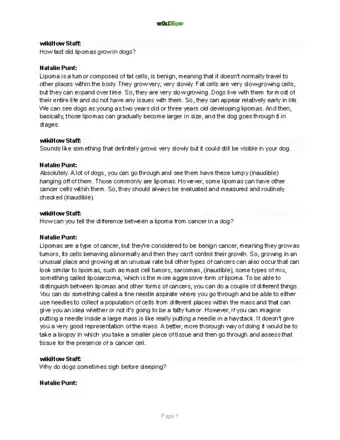
Thanks for reading our article! If you'd like to learn more about taking care of a dog, check out our in-depth interview with Natalie Punt, DVM.
References
- ↑ http://www.globalanimal.org/2013/10/25/how-to-know-if-your-dog-has-been-poisoned/
- ↑ http://www.peteducation.com/article.cfm?c=2+2116&aid=1164
- ↑ http://www.vetstreet.com/dr-marty-becker/what-is-normal-dog-temperature-heart-rate-and-respiration
- ↑ http://www.vetstreet.com/dr-marty-becker/what-is-normal-dog-temperature-heart-rate-and-respiration
- ↑ http://www.globalanimal.org/2013/10/25/how-to-know-if-your-dog-has-been-poisoned/
- ↑ http://www.globalanimal.org/2013/10/25/how-to-know-if-your-dog-has-been-poisoned/
- ↑ http://www.globalanimal.org/2013/10/25/how-to-know-if-your-dog-has-been-poisoned/
- ↑ http://www.globalanimal.org/2013/10/25/how-to-know-if-your-dog-has-been-poisoned/
- ↑ http://www.veterinarypartner.com/Content.plx?P=A&S=0&C=0&A=371
- ↑ http://www.globalanimal.org/2013/10/25/how-to-know-if-your-dog-has-been-poisoned/
- ↑ http://pets.webmd.com/dogs/guide/top-10-dog-poisons
- ↑ http://www.petpoisonhelpline.com
- ↑ https://www.aspca.org/pet-care/animal-poison-control
- ↑ Bates, Nicola, and Nick Edwards. "Emetics In The Management Of Poisoning." Companion Animal 19.8 (2014): 433-436.
- ↑ http://www.veterinarypartner.com/Content.plx?P=A&S=0&C=0&A=371
About This Article
To figure out if your dog has been poisoned, look to see if its gums or tongue are blue, purple, white, bright red, or brick colored. Place your hand on the left side of the dog’s chest and listen for a pulse of 180 bpm or higher. Observe your dog to see if it is vomiting, having diarrhea, are dizzy or disoriented, pant heavily for over 30 minutes, or if it's lost its appetite for over a day. If you see any of these signs, contact your vet immediately. For advice from our Veterinary reviewer on getting professional help, read on!
